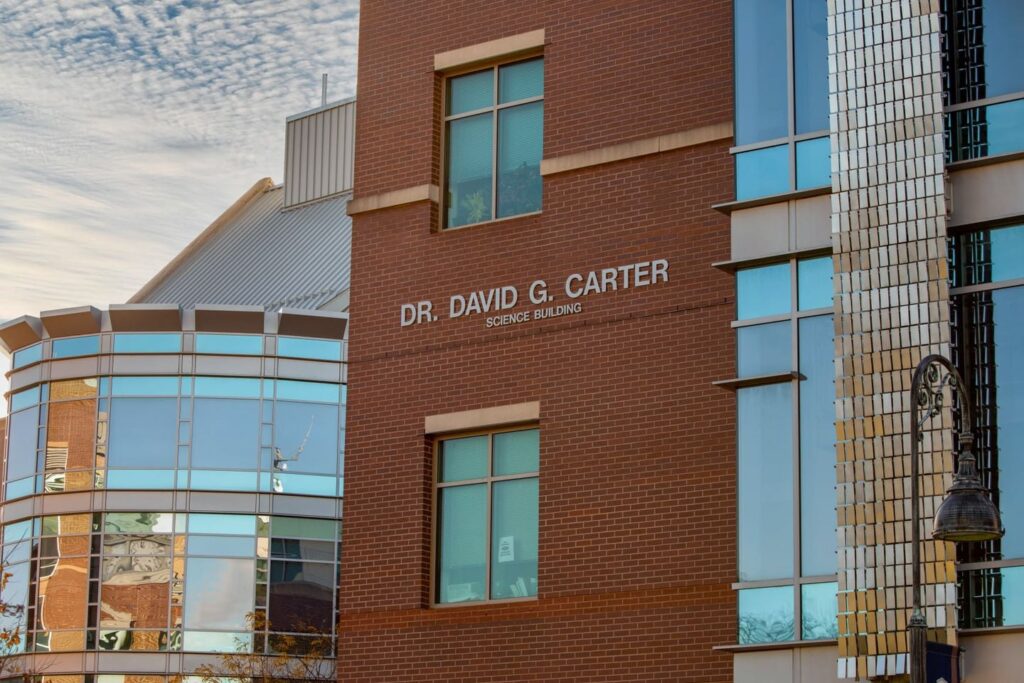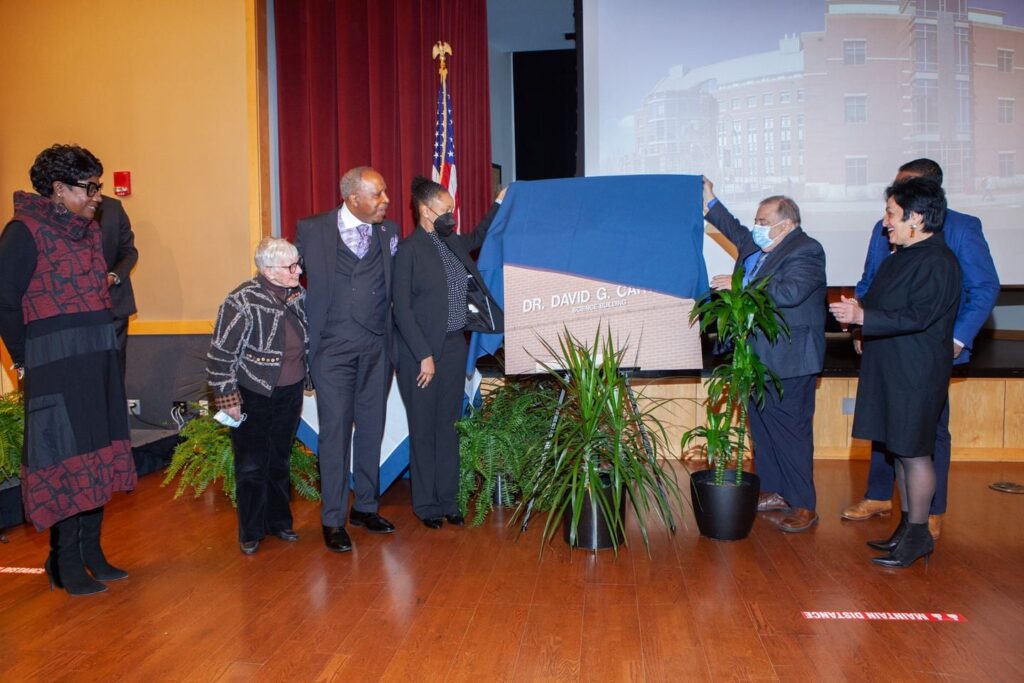By Dwight Bachman
Public Relations Officer
Eastern Connecticut State University
Willimanic, CT – Dec. 7 was a glorious day at Eastern Connecticut State University, as hundreds of people were on hand directly and via a live You Tube stream to join Eastern President Elsa Núñez in paying tribute to the late Dr. David G. Carter Sr. by naming the Science Building on campus in Carter’s honor.
Among Carter’s many accomplishments, he held the distinction of being tapped as the first African-American to head a four-year institution of higher education in Connecticut, when he was selected as the president of Eastern in 1988, where he spent 18 years.
In 2006, he was selected as the first African-American Chancellor of Connecticut’s well-renowned university system. During his five years as Chancellor, Dr. Carter led the university system through its greatest expansion in academic, program and campus development. Most important to him, though, was the growth in student enrollment, which translated into an expansion of educational opportunity.
Before the state-of-the-art Science Building opened in 2008, in 1992, Carter opened two major facilities in the same week!—a renovated Noble Residence Hall and the New Classroom Building, accommodating students and faculty. In 1998, two more facilities in the same year opened!—Niejadlik Hall, which provided more on-campus housing, and new state-of-the art baseball stadium/sports complex.
.
In 1999, four more facilities opened in the same year— the J. Eugene Smith Library, Mead Residence Hall, the new Admissions Building and the Foster Clock Tower. In 2002, Gelsi-Young Hall opened. In 2003, a much-needed parking garage opened. In 2004, Constitution Residence Hall opened. In 2005, Laurel and Nutmeg Residence Halls opened. In 2006, the high-teach Margaret Wilson Child and Family Development Resource Center opened. Later, a new Public Safety Building and the South Residential Village opened, more residence halls for students.
Eastern President Núñez called Carter “a genius.” She said, “The Science Building is the cornerstone of his legacy” and “a testament to his strength of will. He was absolutely committed to giving each student on this campus an outstanding education.”
Theresa Hopkin-Staten, co-chair of the citizen’s committee that initiated the drive for the Science Building naming, said Carter “saw the intrinsic value in every person . . . he led with empathy and perspective, with authentic consideration and care for those in his charge. That is why it is absolutely fitting and appropriate to name The Science Building after him. It represents a place of innovation, inspiration, creation, and action, and Dr. Carter, a man who opened the eyes, minds, and hearts of countless individuals to endless possibilities of greatness.”
Retired Biology Professor Martin Levin recalled that when Carter came to Eastern in 1988, the state legislature wanted to close the campus, but Carter “was a man on a mission with a strong and persuasive voice. He was committed to transforming Eastern into a world-class liberal arts university.” Levin said the Science Building’s original scale didn’t suit Carter and he lobbied for a larger facility. “In 2008, we got our dream building.”
Carter’s daughter Jessica said growing up, “Education helped Dad throughout his life, and that his experience with two women—the Everett Sisters who taught in Dayton public schools, compelled him to never forget those who helped him, to always repay them. Negative encounters from professors taught him to that “appearing too intelligent could be perceived as threatening for others, so he made a habit of keeping a low profile. By the time people realized the depth of his intelligence, it was too late to stop him!” Jessica said Carter knew that education was one of the factors that led to a better life for him, and he paid it forward by helping to provide educational opportunities for others, focusing on the well-being of the students, supporting student growth and development, included securing resources to improve and build university facilities and grounds, including the Science Building.
Other speakers included Chris Abayasinghe ’02, a native of Sri Lanka and now associate vice president of business services at Northeastern University; and LaMar Coleman, vice president for equity and diversity, who served as master of ceremonies.
Coleman introduced what he described as “the moment we’ve all been waiting for”—the Honorable Justice Lubbie Harper Jr., a friend of Dr. Carter’s for nearly four decades.” Harper, who Carter’s children requested to share his thoughts on their incredible father, delivered a powerful and passionate speech. He reminded the audiences that we all were witnessing an historic celebration of a brilliant, visionary man in Dr. Carter.
“Dr. Carter was inspired by the potential of science, Said Harper. “He understood that we are surrounded by technology and the products of science every day. He understood that students growing up in an increasingly technologically and scientifically advanced world need to be scientifically literate to succeed. He wanted students prepared for that reality and wanted Eastern to play a leading role in that field.”
Harper said it is fitting that the remarkable and modern Science Building is a monument to a man who literally helped to build and transform Eastern’s campus. “This is a tangible expression of remembrance, a permanent and concrete expression of respect and gratitude by this university community that he held so dear.”
Harper called Carter a renaissance man, a beacon of hope and a trailblazer. “He was a shining light in the hearts of so many people. He was a man of integrity who sported an infectious smile and possessed an unmatched sense of humor. He was clear about the mission of education, particularly higher education. He was a true educational leader, a skilled administrator and a wonderful human being. He deeply cared about students and believed in giving everyone a chance, and an opportunity to succeed and become a contributing member of our society. He was respected and loved by members of the Willimantic community. He was an advocate for fairness, cared about justice and believed in treating everyone with dignity and respect. He thought outside of the box, had a magnetic personality and pursued excellence with a passion.

Harper said Carter was a consummate educational professional and visionary leader. “He has left a positive and an indelible mark on our state and the Eastern community. Our community felt the force of Dr. Carter’s character as a result of his accomplishments and good deeds over the years. And what resonated within him was a substance that created an amazing man, a man whose dignity was matched by his commitment to serve.”
Harper said Carter had a heart full of grace and a soul generated by love, and he illuminated our hearts with joy. He said God ordered Carter’s steps. “He gave so much to Eastern’s educational community and made a profound difference. Yes, it is fitting that this university, with the blessing of the Board of Regents, is bestowing upon his legacy the honor of naming the Science Building after him. Undoubtedly, he is a most deserving recipient of such recognition that will allow his spirit to glow forever.”
Harper said yes, we all thank the late Dr. David G. Carter for his passion, vision and service, but that we thank him also for something even deeper, a more profound gift that makes this dedication of the naming of the science building in his honor so appropriate.
“It was the gift of his intrinsic goodness, his loyalty, integrity and the purity of his soul. We thank David Carter for all that he did; and for being such a vital and significant part of our state and the educational community. In so many ways, he brilliantly and faithfully served all of us. He fought the good fight and when God called him home, I know in my heart that the angels were smiling for he, undoubtedly, continued to engage in and contribute to a Heavenly community in which he had become one of God’s faithful and devoted servants. We miss you David.”


